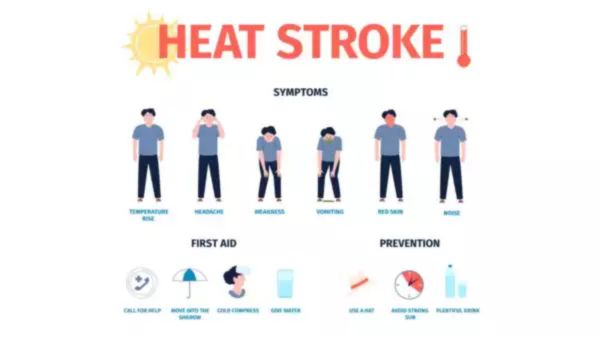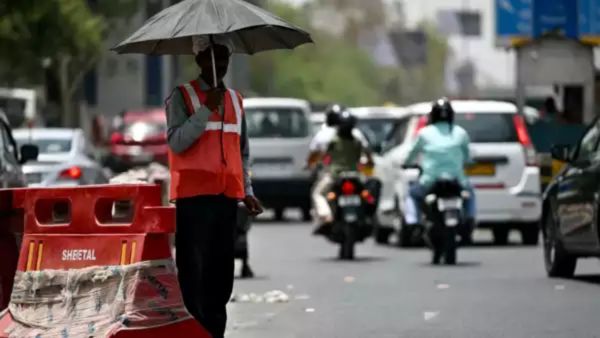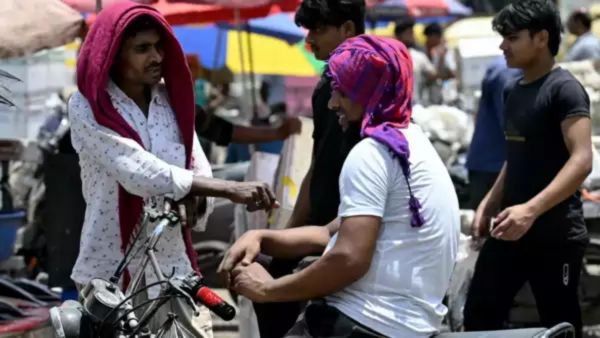
This is at least 7.3 degrees above normal temperature of Delhi during summer at 52.3 degree Celsius.
According to information from Delhi Tourism official website, “Delhi has an extreme climate. It is very hot in summer (April – July) and cold in winter (December – January). The average temperature can vary from 25 degree celsius to 45 degree celsius during the summer and 22 degree celsius to 5 degree celsius during the winter.”
Every year Delhi becomes hotter
Speaking to PTI about why mercury continues shooting up, head of IMD regional office Kuldeep Srivastava said that it was because parts outside are usually hit first by hot winds blowing from Rajasthan plains.
“Some parts of Delhi are more prone to early hits when these hot winds come leading to even worse conditions. When wind blows from west it affects these areas first as they are outskirts thus causing rapid increase in temperatures,” he added.
What IMD means when it issues red alert for Rajasthan, other states –and how it impacts health
Mahesh Palawat, the vice president of Meteorology and Climate Change at Skymet Weather, said, “In open areas with vacant land, there is increased radiation. Direct sunlight and lack of shade make these regions exceptionally hot.” “When wind blows from the west, it affects these areas first. As they are on the outskirts, temperatures rise rapidly,” Palawat added.

Is the data accurate?
“The maximum temperature over Delhi NCR varied from 45.2° to 49.1°C in different parts of city; Mungeshpur reported 52.9°C as an outlier compared to other stations. It could be due to error in the sensor or the local factor. IMD is examining the data and sensors. Temperature over urban areas varies from place to place due to local exposure such as proximity to water bodies, barren land, concrete and dense urban cluster, green areas etc. IMD has five major stations regularly reporting observations since long period and they are referred to as climate stations,” according to what IMD has said.
Vitamin D deficiency raise blood pressure and other medical conditions which may increase risk of heat stroke
“It is not official yet. A temperature of 52.3°C in Delhi is very unlikely our senior officials in IMD have been asked verify this news report”. The Union Minister Kiren Rijiju had tweeted on X about record-breaking temperature of Delhi.
Temperatures above 50 degrees Celsius (122 degrees Fahrenheit) are not just an unusual occurrence but a grave menace to human well-being, infrastructure, and societal functioning. Unusually high temperatures that are caused by global climate change should be understood in terms of their multiple effects for readiness and mitigations.
Impacts on health
There would be extreme temperatures that the body could no longer cope with leading to heat exhaustion or even life-threatening heat stroke. The symptoms include heavy sweating, headache, weakness, dizziness, nausea, confusion and unconsciousness. Heat stroke can cause permanent organ damage or death if urgent medical treatment is not provided. High temperature raises the rate of perspiration resulting in excessive loss of body fluid that, if not replaced can lead to severe dehydration; characterized by dry mouth, lethargy and rapid heartbeat resulting in shock or organ failure.
Low-calorie beverages for summer season
Extreme heat forces the cardiovascular system to work harder as it attempts to maintain normal internal temperatures hence straining it more.Excessive strain may eventually cause heart attacks,strokes and other cardiovascular events especially among those who had such conditions previously.Air quality usually deteriorates during these periods because of higher levels of surface ozone and particulate matter which makes worse respiratory illnesses like asthma and chronic bronchitis.
Prolonged exposure under extremely hot conditions can make individuals become easily irritated, anxious or depressed. Furthermore increased temperatures also affect sleep cycle leading mental fatigue hence causing cognitive impairment.
Senior citizens alongside children are prone to heat-related sicknesses due to their reduced ability to regulate body temperature and higher dependence.Most victims affected by extreme heating are those who have limited access to air conditioning systems, proper housing facilities as well as healthcare services.Poverty-stricken areas frequently lack resources necessary for effectively dealing with threats posed during such episodes.
Their daily lives were heavily affected at 52.3 degree Celsius
The demand for air conditioning units goes up during hot weather, which leads to higher electrical consumption. This could overburden the power grids and result in blackouts or power cuts thus worsening the situation due to lack of cooling systems for people. Extreme heat can cause damage to infrastructure including roads, railways, and bridges.
Increased fluids intake by people as well as their use of water for cooling purposes means that they need a lot of water.The demand can overwhelm the municipal water supply resulting in severe drinking water shortages and rationing. Similarly, high temperatures can result in increased prevalence of harmful algae and bacteria populations in aquatic bodies thereby lowering the quality of water and causing health risks.
Extreme heat could spoil crops leading to lower yields or even crop failure.Heat stress interferes with plant growth and development leading to reduced agricultural productivity and food shortages. Livestock too are sensitive to extreme heat which results into heat stress thereby reducing fertility and increasing mortality rates.

We never have this temperature again when we go back to those ancient practices!
People have been devising various techniques of combating intense heat since time immemorial before modern inventions like air conditioners came into existence. The old ways would therefore contribute significantly towards our understanding on how best nature is preserved during summer seasons.
Buildings with thick walls, high ceilings
Ancient buildings often had thick walls and high ceilings which allowed them to naturally control inside temperatures. Thick walls made from materials such as adobe, stone or mud bricks provide excellent thermal mass where they absorb heat during the day then let it out gradually at night.High ceilings enable hot air rise hence keeping living spaces cooler.
In hot areas, central courtyards formed a part of the traditional homes. It allows fresh air to move in and warm air to get out through these spaces. Additionally, there are shaded sections that reduce general room temperatures.
Badgirs or wind towers as they are called in Persian architecture is an example of this type of architecture designed to catch winds at higher points and channel them into buildings leading to natural ventilation and cooling inside. It can cool down indoor temperatures remarkably without using energy.
Water is used in fountains and pools for cooling purposes
Integrating water features like fountains, pools, and ponds into houses helps lower the temperature of surrounding air. Through evaporation, water absorbs heat from its surroundings thus giving a cooling effect. Ancient palaces and residences located in areas such as Middle East and India had complex systems for maintaining cool environment based on water.
Hanging wet cloths or putting pots with water on the floor may be employed to help maintain low temperatures inside rooms. Heat is soaked during evaporation thus reducing thermal content. This technique still remains commonplace across certain parts of the globe where it’s quite effective given aridness.
Shading and green vegetation
Presence of trees as well as vines gives way for natural shade while at the same time cooling off the atmosphere by virtue of transpiration process. Civilizations like Greece or Rome used to surround their dwellings with trees in order to provide shade which naturally reduces temperature. Most commonly preferred were figs, dates or olives trees.

Vegetation planted on building rooftops and walls can lessen energy absorbed during heating up structures (Whitman 2014). The Babylonians who built hanging gardens practiced this method referred to as green roofing amongst other terms. As such, green roofs along with walls have insulating properties against urban heat island effect (Menon et al 2009).
Cooling yourself through what you wear
Wearing light natural fiber clothes that are loose such as linen and cotton helps keep body cool. These materials allow the flow of air around the body, promote evaporation of sweat, thus cooling off the body. Traditional dressings in hot weather climates such as Indian sari or Middle Eastern attire are designed to keep one comfortable during high temperatures.
Water should be drunk irrespective of what we eat
Foods with a lot of water such as fruits and vegetables help to maintain hydration levels. Melons, cucumbers and citrus fruits were often part of ancient diets in hot regions. Moreover, drinking herbal teas like those made from mint can also have a cooling effect on your body temperature.
It is important to replenish electrolytes lost through sweating. During early times, natural sources for salt like sea salt and preserved food were used for electrolyte balance preserve by primitive people. In India drinks like buttermilk and lassi (yogurt drink) fall into this category since they also provide hydration with essential minerals.
The Japanese practice Uchimizu can help cool the environment
Uchimizu is a traditional Japanese practice where water is sprinkled on streets, gardens and other open places to cool the atmosphere. This simple method has been used in Japan throughout their history to mitigate scorching heat waves in summer months. The practice not only helps in lowering temperatures but also has several environmental and social benefits. With urban areas globally suffering from increased warmth due climate change coupled with urban heat island phenomenon; uchimizu offers an environmentally friendly low-tech approach towards city cooling down processes.

Uchimizu is a traditional Japanese practice where water is sprinkled on streets, gardens and other open places to cool the atmosphere. This simple method has been used in Japan throughout their history to mitigate scorching heat waves in summer months. The practice not only helps in lowering temperatures but also has several environmental and social benefits. With urban areas globally suffering from increased warmth due climate change coupled with urban heat island phenomenon; uchimizu offers an environmentally friendly low-tech approach towards city cooling down processes.
It is through the principle of evaporation that Uchimizu works primarily. Water when sprinkled on hot surfaces absorbs heat from the environment and undergoes evaporation. This process leads to reduced temperature of the surfaces as well as the surrounding air.
Maintain a healthy pair of eyes without diseases in summer
Different substances have different capacities for heat absorption or retention. Urban areas are characterized by many concrete covered streets that tend to absorb much more heat. Uchimizu can reduce momentarily the heat absorbed through these places by sprinkling water on them.
This change in surface temperature helps bring down the overall microclimate temperature and gives rise to cooler pockets within urban landscapes.
Cities often have higher temperatures compared to their rural environs due to human activities and extensive use of materials that absorb heat. This condition is known as urban heat island effect. Regular application of Uchimizu in key areas can create cooler zones, reducing the overall temperature in densely populated urban regions.
In previous times, Uchimizu utilized water remaining after everyday uses such as bathing or even rainwater stored in cisterns, thus promoting conservation of this scarce resource instead of being wasted. Instead of using energy-consuming air conditioning systems, localized cooling can be effectively achieved at low cost with low environmental impact with Uchimizu.
Other things it could do
Sprinkling water settles dust and particulate matter thus improving air quality when they are suspended in atmosphere. This may be very important particularly when there is high levels pollution taking place within towns and cities across the world . Adding humidity into air also reduces concentrations levels of airborne pollutants hence further promoting better quality of this gas medium.
Uchimizu is a way of having fun where neighbors come together to sprinkle water around their common spaces. It creates a sense community among them and establishes collective responsibility towards nature.

Modern urban planning should therefore accommodate Uchimizu as part its design procedure for a built environment. Designing spaces that have permeable surfaces which can appropriately absorb and make use of sprinkled water is one example. Combining Uchimizu with green infrastructure, such as green roofs and walls, can enhance its cooling effects. Vegetation may also cause cooler temperatures through transpiration.
In brief Heat waves must be avoided because they worsen your health by making a long lasting impression on it. Below are some of the effective ways to overcome heat wave:
- Drink enough amount of water during the day time and minimize intake of alcohol, caffeine or drinks that contain sugar since they can cause dehydration.
- Wear clothes that are lightweight, loose fitting and light colored in most cases. Also wear wide brimmed hats as well as sunglasses when going out into direct sunlight.
- Do not go outside from 10am-4pm when the sun is at its brightest or seek out shade where possible
- Apply sunscreen with an SPF rating that is above 30 to shield yourself against harmful UV rays.
- Remain indoors in air conditioned rooms or shaded areas whenever possible . Use fans or cold towels if there’s no access to air conditioning.
- Reduce, reschedule or cancel strenuous outdoor activities especially during the hottest parts of the day.
- Heat stroke symptoms include high body temperature; red hot dry skin; fast pulse rate; headache ; nausea , dizziness , confusion , coma ; unconsciousness . Emergency medical help should be sought if they arise .
- Ensure elderly individuals, kids or those with medical problems are kept cool and hydrated.







